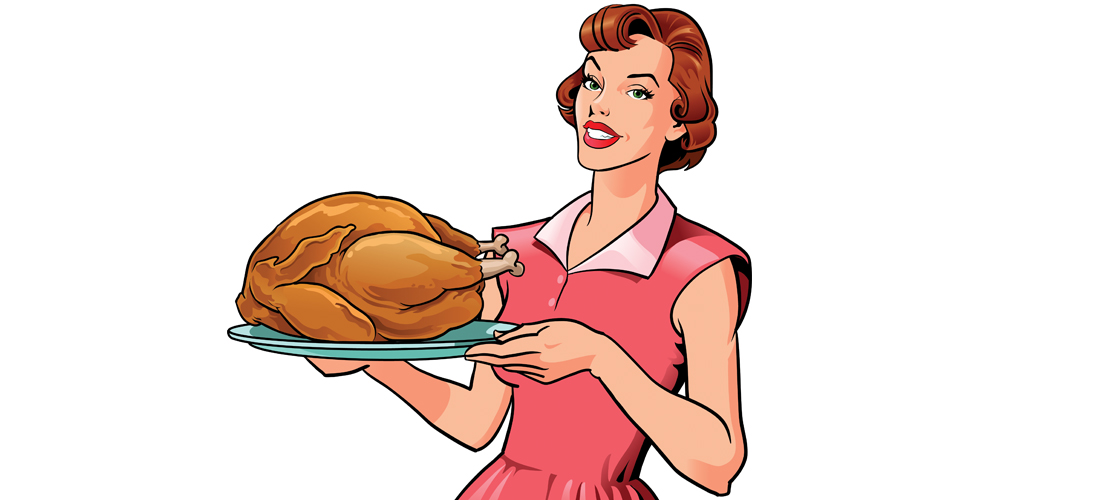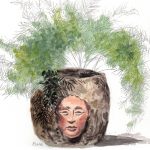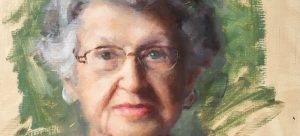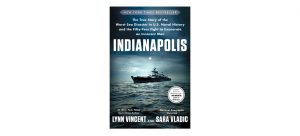
Thanksgiving in Hell’s Half Acre
Praise be to the Butterball Talk Line
By Cynthia Adams
Just like Babs Streisand sang, “Memories may be beautiful and yet/ What’s too painful to remember/ We simply choose to forget.”
Yet I cannot forget the damn turkey and start having flashbacks in October.
Come Thanksgiving, as I bow my head in submission to those elders who refuse to break with a deadly culinary tradition, I always remember my friends at the Butterball Talk Line. I keep them on speed dial.
These noble women (and one man) stand by to save us from “last-minute snafus, flubs, and foul-ups.”
Our annual family flirtation with salmonella is definitely the latter: a colossal fowl-up.
These noble Butterball people save lives and field 100,000 calls. Every. Single. Year.
So, while the experts at Butterball side with me, they could not solve our ancient culinary conundrum.
My grandmother and mother determinedly baked a lethal Thanksgiving turkey each year due to the ancestral recipe.
A great-great-great-great grandma, one who was rumored to have killed a tax collector with a fire poker, was banished to the colonies. It is unclear if she did or did not flee Ireland with a copy tucked under her skirts of Grandma’s Most Foul Recipes.
Remember, great-great-great-great grandma was an accused murderess.
Fast-forward to her descendant Pat McClellan Tucker, my grandmother, a heckuva cook. This scrappy lady could have written Ted Nugent’s Kill It & Grill It. Call it cell memory of the tragic starvation in Ireland, but she ate anything with feet and a face.
And, she perpetrated our Irish exile’s dangerous practice that should have killed us all. Keep a stuffed bird juicy by this method:
Warm the oven, put the turkey in for a few hours, then turn off the oven and let the bird sit in solitary overnight. Thereafter, the bird idles in a toxic salmonella stew.
Somehow, some way, nobody died at the table. (Well, except my grandfather.) Actually, most of the menfolk on my paternal side fell dead prematurely. But those of us descended on the maternal line prevail.
We have developed salmonella-resistant genes.
Go ahead, 23 & Me! Test us! We are the missing link when it comes to eating partially cooked fowl and surviving!
We developed adaptive survival, especially when eating undercooked turkey.
There was little irony in this. Vegetables, on the other hand, were cooked until they turned gray in surrender, then drowned and dredged them in yellow margarine.
The women made green-bean-and-mushroom-soup casserole, topped with a pile of French’s fried onions. Also, mashed potatoes, of course, and creamed corn that became a surreal, sallow yellow. They baked sweet potato casserole, swimming in margarine and brown sugar, smothered with toasted marshmallow.
You could hear arteries clogging at the Thanksgiving table . . . a sort of strangled, muted congestion in the lower register of human sound.
In Hell’s Half Acre, the idea that excess is best prevailed. My mother and grandmother began baking pound cake, along with pumpkin, sweet potato and pecan pies after Halloween.
They worked themselves into a fever, assembling dishes from educational TV’s Forgotten Foods documentary.
You know what these are — dishes that have fallen from fashion. Like pear salad, stuffed with cream cheese, dolloped with twee bits of green pepper for garnish. Congealed salads, too, which meant, Jell-O with floating bits of shredded carrot and canned pineapple. Occasionally (“for color”) my mother veered off into a green Jell-O concoction with cream cheese, whipped cream and nuts. Or tomato aspic.
They stuffed celery with pimento cheese and piped whipped egg into egg halves, garnished everything with pimento bits, then dusted that off with paprika.
They assembled relish trays, with watermelon pickles, beet pickles, and bread-and-butter pickles. Olives and pickled onion were also dotted around.
Also, like N.C. chef Vivian Howard’s family, mine also lacked the self-control for appetizers, so my grandmother and mother served everything all at once.
At the very last, the night before T-Day, they prepared the dressing and stuffed the turkey . . . oh dear God, the stuffed turkey.
Because a WBTV cooking show host once extolled the value of adding apple to the sausage dressing, my mother altered her recipe, with tragic results.
Thereafter, chopped apple was in the mix.
The dressing the women in my family made required crumbled biscuits, sausage (“with fresh sage!” my grandmother would trill) onion and other dried spices.
The unfortunate modification to this was the chopped apple. “It keeps things moist,” my mother would say, well satisfied.
Moist was a watchword, mind you . . . only part of what scared me stiff about the stuffed turkey.
The next day when my mother would pull the cooled-down turkey out of the oven, only a slight bit of the poor creature looked cooked, at least to my eye, as my father would heartily prepare to slice and dice the bird.
I couldn’t look, as spoons full of the grayish dressing with a pound of chopped apple bits were placed around the platter. The turkey, which did appear brown on the outside, was admittedly very, very moist.
(Wait — was it perhaps raw? I wondered)
Yeast rolls, which had been patiently rising, awaiting the turkey’s exodus from the oven, were popped in last.
At the table, I pushed the obligatory piece of turkey aside and ate some of the hundreds of other items that abounded.
“She’s always been a picky eater,” my mother would say, eyes narrowing.
Once I grasped the perils of the lukewarm baked turkey method, which was as soon as I could spell salmonella, I’ve battled my mother. She was apoplectic when she watched me prepare a bird during a Thanksgiving visit years later.
“That is not how we make a turkey in this family,” she muttered, tight lipped.
We crossed swords. “It’s dangerous, Mom.”
“Nobody died!” my mother shouted, clutching her pearls. “I never killed any of you!” her face reddened, looking the image of Shirley MacLaine in Terms of Endearment.
“Not for lack of trying,” I muttered.
My mother stood up as if to jump in her Lincoln Town Car and head home to Norwood.
“It isn’t safe, Mom!” I bleated.
To make my point, I called the Butterball hotline as she watched, her jaw set, arms crossed like she was General Patton. There was no one, nada, who would endorse the ancestral method.
Afterward, Mom didn’t exactly clutch her heart but she looked ashen. To keep the peace, I did as she insisted, but refused to stuff the damned thing and baked the dressing separately. (She stood up again at this rebellion, clearly upset.)
And I further refused to add apple, which makes the dressing a sodden mass.
I now call the ancestral recipe, Trussed Up Tragedy, which you can read in my book, Jim Jones’ Greatest Hits: How to Prepare Turkey for a Mass Suicide. Luckily, thanks to that aforementioned genetic mutation, we did not die en masse at the Thanksgiving table. We had the good graces to die elsewhere.
(Just think: Had Thanksgiving originated in Ireland, my murderous great-great-great-great could have innocently offered that tax collector a leftover turkey sandwich, and nobody would have been the wiser.)
The preparation of turkey appears to be a mystery for the ages, however. Over time, Butterball has expanded from 11 helpful helpers in the 1980s to more than 50 today, and they will take a staggering number of desperate calls straight through December.
The Butterball reports are tragicomical: callers who discover an ancient turkey in the bottom of a rusty freezer and hope it’s edible, or wonder if they can fast-thaw a stone-cold bird in the dishwasher. Or, the multi-tasker who questioned if they can thaw the turkey in the bathwater with baby. The Butterball people listen, give counsel, and wish you well. They even text.
Count the good people at Butterball among your blessings this November.
That number, dear readers, is 1-800-BUTTERBALL (1-800-288-8372). OH
Cynthia Adams, now vegetarian, is volunteering for the tofurkey hotline this year.





